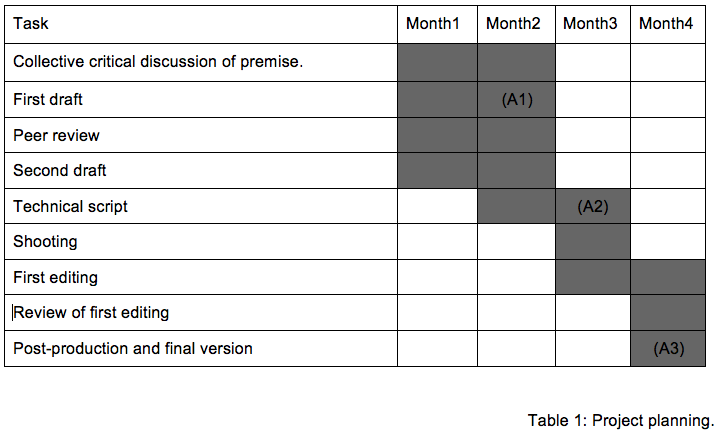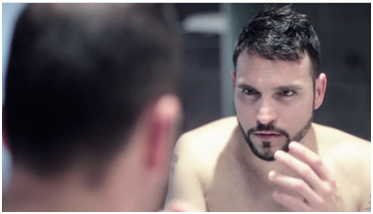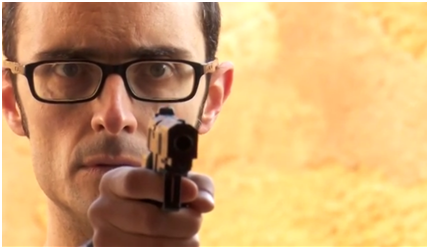Cinema Journal Teaching Dossier Volume 3 (1) Winter 2015 Antoni Roig and Talia Leibovitz Universitat Oberta de Catalunya/IN3
This paper presents the first results of an on-going experiment on distributed creativity in screenwriting and film creation, which is taking place in the Audiovisual Final Project of the online Degree of Communication of the Open University of Catalonia. In this initiative, we have taken advantage of our ongoing research in participatory filmmaking (Roig 2009; 2013) and crowdsourcing in cinema (Roig, Sánchez-Navarro & Leibovitz, 2012; Leibovitz, Roig and Sánchez-Navarro, 2014). Furthermore, we have applied our experience in the design of collaborative creative environments and tools (see Creus et al., 2014), where we focus on stimulating cross-disciplinary social skills to understand and solve complex problems through co-creation (as stated by Sutherland, Eagle & Joubert, 2012), taking into account that online environments are particularly suited for the collaborative construction of knowledge and learning (Gros et al., 2009; Luther et al., 2010).
Institutional background and project justification
The Universitat Oberta de Catalunya (Open University of Catalonia, from now on UOC), established in 1995 and based in Barcelona, is a pioneering online higher education institution with a strong commitment to internationalization. The UOC began teaching a Degree on Audiovisual Communication in 2002, and one of the authors of this paper was the designer of its curriculum. In 2009, a new Degree in Communication, adapted to the requirements of the European Higher Education Area, was created. Drawing from the experience from the previous degree and taking advantage of the enormous technological, social and cultural advancements for online creativity at all levels, different initiatives have been fostered to turn the challenges for media creation in an online environment into advantages for collaborative work and innovation. In the Audiovisual Communication degree we use mainly three key strategies for content creation:
- Shared resources through creation, edition and remixing of CC-licensed raw material.
- Transdisciplinary online space for production and direction through teamwork.
- Personalized guidance for individual short format production and longer format projects.
In the new Communication degree, the Final Project subject adds further emphasis on collaboration and sharing skills and content through a practice-based and professionalized environment, plus visual tools for oral presentation. For our purposes, instead of focusing on personal projects under the guidance of a professional expert, we have developed a collective project defined in specific but still broad terms that focuses on both collaboration and creativity. The main challenge for a coordinated online filmmaking project is the physical distance between participants. Therefore, a sort of distributed creativity strategy seemed like the more convenient way to go. From there, we had to choose between two possibilities:
- A single project/ team with task specialization.
- A project made of multiple pieces and teams.
We chose the second possibility in order to test as wide a range of skills as possible. After weighing the option of developing a documentary under a common subject/ topic, we opted to undertake an experiment with fiction for one main reason: its own complexity. Fiction allowed us to work more fully in all the key elements from screenwriting to pre-production, shooting and post-production. Our goal was to combine creativity with a series of well-defined specifications in terms of conceptualization, format and production values.
Therefore, we opted for a collaborative endeavor based on distributed creativity, and we designed a premise in the form of a networked and distributed narrative (as stated by Walker, 2004).
The premise: description and justification.
A man/ woman wakes up in a hotel room. New place. New body. On the bedside table, an envelope with the instructions for the day, some pills, a cell phone, a gun and another closed envelope only to be opened in the case of an emergency. In the wardrobe, as usual, the same kind of functional clothes. She still remembers the first day of this nightmare.
This is the first paragraph of “The Awakening” narrative premise, one part of the two documents students are given on the first day of the course. It is intended as a way to raise expectations and to set the tone for the final product, while keeping it open to interpretation. The full activity document is structured as follows:
- Overview of the job and work methodology.
- Narrative premise (excerpt above).
- Format of the final product.
- Suggested questions as inspiration.
Once the open fictional world premise is presented, every student is asked to individually elaborate a short script within this shared universe: all together will eventually end up forming a longer short episodic movie. Actual plot, genre and visual approach are open, as long as every piece is coherent with the premise and some broad tech specifications. Thus, before creating the first version of the scripts, students share their vision of the fictional world, foresee possible development challenges and share their own synopses in the virtual classroom. Once the first drafts are written, they are distributed for random peer-evaluation, thus securing coherence with the premise ‘rules’ and assessing possible production issues for a ‘no budget’ production. Consequently, even if the original author makes the second draft, it is already fruit of a participatory process through peer feedback on the script. In consequence, the original author is in charge of shooting and editing process with a team of her choice, under supervision of tutors, who provide general feedback and facilitate filmmaking equipment if needed. In the end, each student is writer/ director of her own original story (3-5 minutes at most) and engaged in a peer’s project as script reviewer. Finally, edited versions are collectively assessed and overall order of the pieces are decided.
An additional support document details tasks to be developed, timing and calendar. As the term lasts four months, the following structure was defined:
Although the project demands a continuous process of dialogue between students and tutor, three partial assessment milestones were proposed (marked in Table 1): first script (A1), pre-production pack (A2), including definitive literary and technical scripts plus any other possible support material) and final edited version (A3).
Pilot experience
For the pilot experience we worked with a reduced group of five students, with both authors acting as tutors. It is important to note that we had written more background story than was given to students: it helped us to have a bigger picture of the narrative without compromising creativity. In broad terms, planning was maintained and these were the main issues observed:
- Understanding the project’s overall aim was the object of most of the initial questions.
- The concept was not much discussed nor challenged, but we got some suggestions and interpretations prior to script development. Some of them diverged from our ‘hidden’ background story (for instance: one idea revolved around AI, which was completely unrelated), but we decided to keep them as they opened the concept in unexpected ways, thus prioritizing creative freedom.
- We discussed whether to allow students to shoot their own written material or to pass it to another colleague in order to emphasize its dimension of professional teamwork rather than individual effort. Being a pilot experience, we decided to let them keep full control over their own material.
- Students shot their pieces with their own equipment.
Feedback and future development.
Feedback from students, collated from a survey at the end of the process, has been mainly positive. The most remarkable observations were those related to peer collaboration, learning process, fun, guidance, professionalization, challenging nature, the diversity of approaches and development from a single shared premise and creative freedom. Negative comments focused on organizational hurdles, time and plot constraints, dilution of initial premise in some cases, and uneven production means and needs. For future editions, participants suggest lesser constraints in some aspects (i.e. running time), more delimitation on others (i.e. maximum number of actors) and shooting other peer’s scripts. Curiously, there are different perceptions regarding whether there should be a tight initial premise or not, but there is an agreement that a shared premise helped the collaborative creative process.
We plan to replicate the experience with the same concept in order to have enough material for public release and to collect more elements for analysis. We will focus on not only the particularities of the project in itself but also the production issues, from technical tips (sound, lighting, camerawork) to production limitations (sets, actors, props, etc.). We will also encourage more initial discussion in the group in order to strengthen collaboration, decision-making on the actual creative process and debate on the concept and its potentialities. Additionally, we will be setting up a public page for the project with the help from other communication students interested in the fields of social media strategies and web design.
References.
Creus, Amalia; Ornellas, Adriana, Lalueza, Ferran, Roig Antoni, “Learning and Creating in Peers: Analyzing Students’ Experience in two Computer-Supported Collaborative Learning Environments”. In European Conference in the Applications of Enabling Technologies. Glasgow, November 20-21, 2014.
Gros Salvat, Begoña; Lara-Navarra, Pablo; García González, Iolanda; Mas García, Xavier
López Ruiz, Jose; Maniega-Legarda, David and Martínez, Toni. The UOC’s educational model: Evolution and future perspectives. Universidad Oberta de Catalunya Ed. 2014. Accessed: June 1, 2014. http://hdl.handle.net/10609/7263
Leibovitz, Talia; Roig, Antoni and Sánchez-Navarro, Jordi. “Collaboration and Crowdfunding in Contemporary Audiovisual Production: The Role of Rewards and Motivations for Collaboration”. In Cinergie, il cinema e le altre arti (4). 2013. Acessed 28th January, 2015. http://www.cinergie.it/?p=3214
Luther, Kurth; Caine, Kelly; Ziegler, Kevin and Bruckman, Amy. “Why it works (when it works): Success factors in online creative collaboration”. In Proc. Int. Conf. Supporting Group Work (GROUP), pag.1–10. ACM, New York, 2010.
Roig, Antoni. Cine en conexión: producción cultural y social en la era cross-media. Barcelona: Editorial UOC, 2009.
Roig, Antoni. “Participatory filmmaking as media practice”. International Journal of Communication (7). Los Angeles: University of Southern California, 2013. Accessed 17th January, 2015. http://ijoc.org/index.php/ijoc/article/view/1593/1013
Roig, Antoni; Sánchez-Navarro, Jordi and Leibovitz, Talia. “¡Esta película la hacemos entre todos! Crowdsourcing and crowdfunding como prácticas colaborativas en la producción audiovisual contemporánea”. Revista Icono14 10-1, 2012.
Sutherland, Rosamund; Eagle, Sarah and Joubert, Marie. A vision and strategy for technology enhanced learning: Report from the STELLAR Network of Excellence. 2013
Walker, Jill. “Distributed Narratives: Telling Stories Across Networks”. Presented at AoIR 5.0, Bristol, 2012. Accessed 17th January, 2015. http://jilltxt.net/txt/Walker-AoIR-3500words.pdf



